Miko Shrine Maidens: Japan's Traditional Shinto Priestesses
- Published on : 14/06/2024
- by : Japan Experience
- Youtube
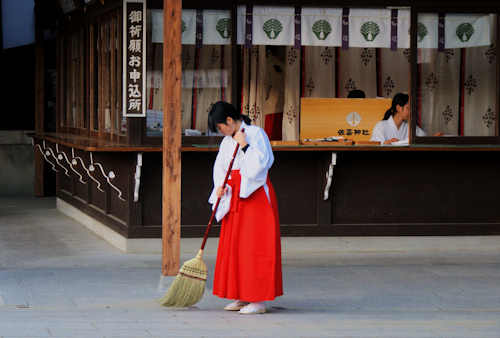
Cleaning the shrine grounds and working in the shrine shop are two of the main activities for contemporary miko
In the enchanting world of Japanese Shinto tradition, miko shrine maidens stand as iconic figures, bridging the gap between the earthly and divine realms. These young women, adorned in their distinctive red and white attire, have played a significant role in Japanese spirituality for centuries. From their ancient origins as powerful shamans to their modern-day duties at shrines across Japan, miko continue to captivate visitors with their grace and spiritual significance. Join us as we explore the fascinating world of miko shrine maidens, their evolution through history, and their enduring importance in contemporary Japanese culture.
The role and significance of miko in Shinto tradition
Miko, also known as shrine maidens, have long been an integral part of Shinto tradition. These young women serve as intermediaries between the human world and the divine realm, acting as vessels for the kami (Shinto deities) to communicate with mortals. Their role is deeply rooted in the belief that young women possess a special spiritual purity that allows them to serve the kami effectively.
In ancient times, miko were considered powerful religious and political figures, wielding significant influence in Japanese society. They performed various functions, including:
- Conducting sacred rituals and ceremonies
- Performing divination and fortune-telling
- Acting as spirit mediums to channel messages from the kami
- Offering prayers and blessings to visitors
- Performing sacred dances, such as the kagura
Today, while their role has evolved, miko continue to play a crucial part in Shinto practices. They assist priests in various shrine duties, participate in ceremonies, and help maintain the spiritual atmosphere of the shrine. Their presence adds an air of grace and tradition to Shinto shrines, making them an essential element of the Japanese spiritual landscape.
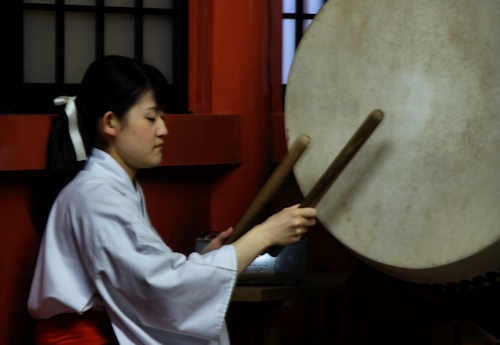
Miko playing a taiko in a ceremony at the Toshogu Shrine in Hiroshima
Historical evolution of miko from ancient times to modern day
The history of miko dates back to the prehistoric Jomon period, where they were revered as powerful shamans capable of communicating with the spirit world. Over the centuries, their role has undergone significant changes, reflecting the evolving religious and political landscape of Japan.
In ancient Japan, miko held positions of great power and influence. The earliest written records mention figures like Himiko, a shaman queen who ruled over parts of Japan in the 3rd century. During the Nara (710-794) and Heian (794-1185) periods, miko continued to play important roles in court rituals and local spiritual practices.
However, with the rise of Buddhism and Confucianism, the spiritual authority of miko began to wane. Male priests gradually took over many of their functions, and miko were increasingly relegated to supporting roles. During the Edo Period (1603-1868), some miko became associated with itinerant performers and even prostitution, further diminishing their sacred status.
The Meiji era (1868-1912) brought significant changes to the role of miko. In 1873, the government issued an edict called Miko Kindanrei, which forbade all spiritual practices by miko. This marked a turning point in their history, as many of their traditional shamanic functions were officially suppressed.
In modern times, the role of miko has been largely institutionalized. While they no longer perform the powerful shamanic rituals of the past, they continue to play an important part in Shinto shrine activities and ceremonies, preserving elements of their ancient traditions in a contemporary context.
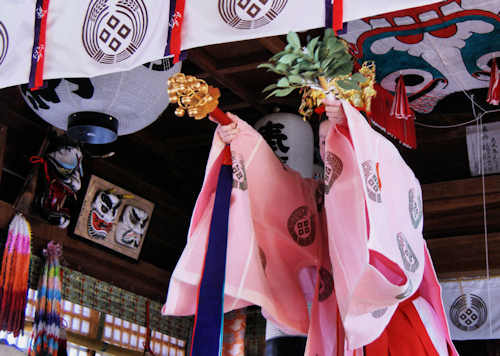
A single miko performing miko mai, or miko kagura
Appearance and traditional attire of miko
The distinctive appearance of miko is one of their most recognizable features. Their traditional attire, known as miko shozoku, consists of a few key elements:
- Hakui (白衣): A white kimono-like robe symbolizing purity
- Hibakama (緋袴): Bright red pleated trousers or a long, divided skirt
- Tabi (足袋): White split-toed socks
- Zori (草履) or Geta (下駄): Traditional Japanese sandals
For certain ceremonies or dances, miko may also wear a chihaya (千早), a white coat worn over their usual attire. This garment is often decorated with colorful designs or patterns related to the specific shrine or ceremony.
The miko's hair is typically worn long and straight, tied back in a low ponytail. Some shrines use white or red ribbons to secure the hair, adding to the overall aesthetic. During special occasions, miko may wear elaborate hairpieces called hanakanzashi or a special crown known as a kanmuri.
This striking red and white ensemble symbolizes the balance between purity (white) and vitality (red) in Shinto belief. The simplicity and elegance of the miko's appearance contribute to the serene atmosphere of Shinto shrines and serve as a visual reminder of Japan's rich spiritual heritage.
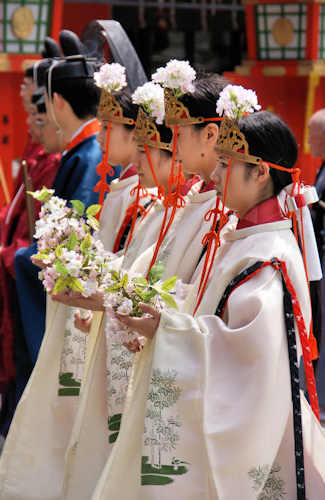
A group of miko in ceremonial dress at a major festival
Training and qualifications to become a miko
Becoming a miko in modern Japan is quite different from the intensive shamanic training of the past. Today, the primary requirements are generally to be of sound mind and body, and to be a young, unmarried woman. The typical age range for miko is from late teens to mid-twenties, though this can vary depending on the shrine.
While there are no standardized qualifications or certifications required to become a miko, many shrines provide their own training programs. This training usually covers:
- Shrine etiquette and proper conduct
- Basic knowledge of Shinto beliefs and practices
- Ceremonial procedures and rituals
- Performance of kagura and other sacred dances
- Handling of shrine offerings and amulets
Some miko may choose to pursue more formal education in Shinto studies at institutions like Kokugakuin University in Tokyo or Kogakkan University in Ise. These programs offer in-depth knowledge of Shinto theology, history, and practices, though such extensive study is not typically required for most miko positions.
Interestingly, many modern miko are university students or young women working part-time at shrines. This allows them to experience traditional Japanese culture while earning some income. Some shrines, particularly during busy periods like New Year's, may hire temporary miko to assist with the increased number of visitors.
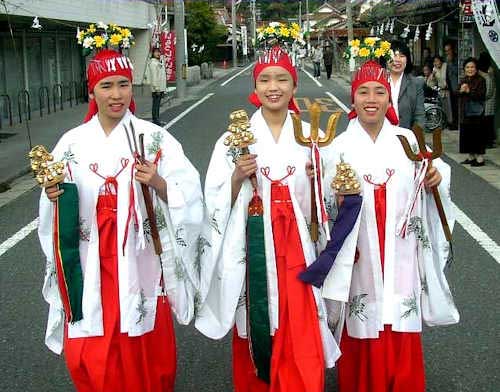
Three young miko in a procession following a festival in a small village
Duties and responsibilities of contemporary miko
While the role of miko has changed significantly over time, they still play an important part in the daily operations and spiritual life of Shinto shrines. The duties of contemporary miko typically include:
- Assisting priests in rituals and ceremonies
- Performing sacred dances (kagura) during festivals and special events
- Selling omamori (amulets) and ofuda (talismans) to visitors
- Offering omikuji (fortune-telling paper strips)
- Guiding visitors and answering questions about the shrine
- Maintaining the cleanliness of the shrine grounds
- Helping with administrative tasks and office work
During major festivals or busy periods like New Year's, miko may have additional responsibilities such as assisting with crowd control or participating in special ceremonies. Some miko may also be involved in outreach activities, helping to educate the public about Shinto traditions and practices.
It's important to note that while miko assist in many aspects of shrine life, they do not perform the main priestly duties. These are reserved for Shinto priests, known as kannushi, who undergo more extensive training and certification.
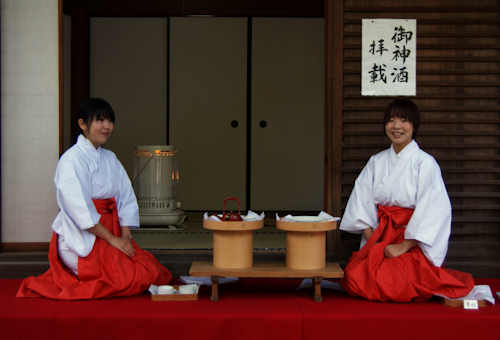
A pair of miko serving o-miki, sacred sake, during the New Year at a shrine in Kyoto
The Kagura dance: A sacred miko ritual
One of the most captivating aspects of miko tradition is the performance of kagura, a sacred Shinto dance. Kagura, which literally means "god-entertainment," is believed to have originated from the mythical dance performed by the goddess Ame-no-Uzume to lure Amaterasu, the sun goddess, out of her cave and bring light back to the world.
In modern Shinto practice, kagura serves multiple purposes:
- Honoring and pleasing the kami
- Purifying the shrine and its visitors
- Telling stories from Shinto mythology
- Inviting the presence of kami during rituals
Miko typically perform kagura during important shrine festivals and ceremonies. The dance is characterized by slow, graceful movements and the use of various props such as fans, bells, or sacred branches. The miko may wear special attire for these performances, often including the chihaya over their usual costume.
Learning kagura is an important part of miko training, as it requires not only physical skill but also a deep understanding of its spiritual significance. The dance serves as a living link to ancient Shinto traditions, allowing modern visitors to experience a glimpse of Japan's rich spiritual heritage.
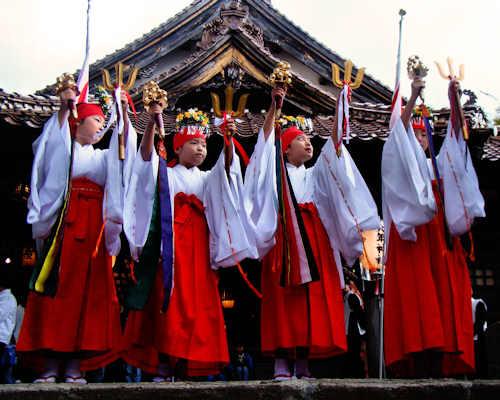
Four young miko performing miko mai at an small shrine's annual festival
Types of miko in modern Japan
In contemporary Japan, there are several types of miko, each with slightly different roles and traditions. The ethnologist Kunio Yanagita identified three main categories:
- Jinja miko (神社巫女): These are the most common type, attached to Shinto shrines. They perform kagura dances and assist in various shrine functions.
- Kuchiyose miko (口寄せ巫女): These miko act as spirit mediums, speaking on behalf of the deceased. While less common today, they can still be found in some areas, particularly in northeastern Japan.
- Kami uba (神姥): These miko engage in cult worship and invocations. They are often associated with new religious movements or local folk traditions.
Additionally, researchers have identified other specialized types of miko, including:
- Itako (イタコ): Blind female shamans found primarily in northern Japan
- Moriko (森子): Miko associated with mountain worship, often found in central Japan
- Nono (のの): A type of wandering miko found in central Japan
It's worth noting that while these traditional categories still exist to some extent, the vast majority of miko in modern Japan fall into the jinja miko category, serving at established Shinto shrines.
The diversity of miko traditions reflects the rich tapestry of Japanese spiritual practices. While many of the more esoteric forms of miko practice have declined in recent years, the enduring presence of miko at shrines across Japan ensures that this ancient tradition continues to play a vital role in contemporary Shinto practice.
As we've explored the world of miko shrine maidens, from their ancient origins to their modern-day roles, it's clear that these young women continue to be an integral part of Japan's spiritual landscape. Their graceful presence at shrines, their performance of sacred dances, and their assistance in rituals all contribute to the preservation of Shinto traditions. While their role has evolved over the centuries, miko remain a powerful symbol of the enduring connection between the human and divine realms in Japanese culture.









